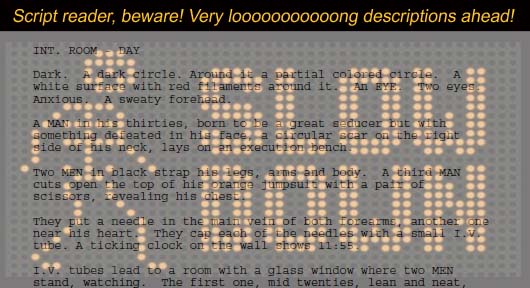No wonder that Formatville's motto is:
"Live by its 10 commandments or" - like Donnie Brasco would say - "Fuhgeddaboudit"
So if you want YOUR screenplay to be read and not tossed, apply these script formatting guidelines. Today the third commandment.

We asked our format expert, Matt, aka Formatman, to lead us through the 10 formatting commandments.
If you missed the introduction to this series of articles, you may want to check it out first.
Here is the link to Part 1, where it all started.
Whatascript:
What is this screenplay format commandment about? and why is it important?
Formatman:
Your job as a screenwriter is to make sure the reader turns the pages of your screenplay. And the faster he does it, the higher the chances you have to get a "recommend" or "consider" on your script coverage report.
So how do you do that?
Well, as far as screenplay format is concerned, you make sure you follow all 10 commandments and this one in particular.
Everything you do that slows down the reader, makes him wonder if he should turn the next page or go to the next screenplay on his pile.
Whatascript:
How can the screenplay format contribute to a speedy reading?
Formatman:
There are many ways. I will focus here on 3 aspects: descriptions, characters and comments.
Formatman:
After the mastery scene heading - see screenplay format commandment #2 for a complete explanation on what it is and how to use it - the next part of your script is the description.
This is where you write what's important about the location and the action that takes place.
A few guidelines:
We all heard or had the experience of a reader skipping long descriptions and jumping straight to the dialogues. So focus on paragraphs of 3-4 lines.
The description includes the following elements:
Mix actions and dialogues, to avoid long blocks of descriptions/actions.
See movie dialogue rule #4 for an example.
Write in the present tense (e.g. he runs). That means NO present progressive tense (he's running), past tense (he ran) or passive tense (he was run down)in your screenplay format.
Everything you write is something that can be seen and therefore filmed.
Said another way, what you can NOT see, do NOT write it.
Describe only what's relevant to move the story forward.
In other words, do not write the obvious or anything that is not necessary.
If I write "a bedroom". You will picture a bedroom, maybe yours. And you will imagine the furniture that belongs to such a room. There's thefore no need to describe it - it would just slow down the reader.
Only exception is when the description of the bedroom would be relevant to the story and for example reveals something important about the character.
This is an example of Good Will Hunting written by Matt Damon & Ben Affleck to illustrate this point:
Will sits in his apartment, walls completely bare. A bed, a small night table and an empty basket adorn the room. A stack of twenty or so LIBRARY BOOKS sit by his bed. He is flipping through a book at about a page a second.
Everything in the room is reduced to its strict necessary - apart from the library books, which are in abundance. This contrast gives the reader access to the world of Will, which is all based on books versus his own experience. And that is very relevant to the story.

Write in a concise, sharp and active manner. This is NOT a novel.
The principle that David, aka Blablator talks about in dialogue rule #3, "less is more", applies here too. No long description. Just the essential.
This is an example from the Cider House Rules, written by John Irving, to illustrate this point:The film breaks--to huge cries of disappointment from the orphans. Fuzzy coughs and coughs while Larch fumbles with the projector. Angela turns on the light while Larch squints at the broken film. The orphans are chanting, "Kong! Kong!"
Your screenplay is not the place either to show your knowledge, unless it is relevant to the story.
If some plants got damaged, it's enough for the reader to know that insects were the culprits. No need to mention that their name was zyzzyva.
Use words that pictures something and check if they express what you exactly mean.
Compare "Tom speaks" to "Tom whispers, perorates, lectures, utters, babbles or grumbles".Each word creates something different in the reader's mind.
Beware fillers like "he stands up and leaves", "he lights a cigarette" unless they are crucial to the story (e.g. the cigarette is filled with poison).
Don't mention the obvious.
If the screenplay format of the master headings is "INT. OFFICE - DAY" don't write: "Max enters the office", but "Max enters".
He cannot enter any other room since the scene takes place in the office.
With respect to sounds, screenplay format guidelines are not as tight as they are for mastery scene headings for example.
Generally speaking, don't cap all the sounds as it slows down the reader.
A general rule in screenplay format recommends to only cap sounds when you think they are important to the scene and you want to make sure the reader "HEARS" them.
In addition to above rule, cap only sounds coming from objects (e.g. telephone) or people that you cannot see in the scene.
These are 2 examples from The Bourne Supremacy - screenplay written by Tony Gilroy:
He [Bourne] goes to the front door finds "Sewell and Marbury" and rings the bell. No answer.
No caps for RINGS or BELL, as we see the bell. But ...
A beat -- long unbroken. BOURNE What are you doing here? NICKY I was posted here after Berlin. BOURNE Where's Daniels? The office PHONE goes.
In this case we don't see the phone when it rings. Therefore it's capped.
Technically speaking the screenplay format of the descriptions look as follows. They:
-- are aligned between 1 1/2" (3.81 cm) and 7 1/2" (19.05 cm) and
-- are written in paragraphs, separated by a single blank line.
Whatascript:
You just talked about the setting and the action. What about the characters? what to do in terms of screenplay format not to slow dow the reader?
Formatman:
Here are a couple of advices:
Make sure you have a limited number of main characters and their name is simple - hopefully meaningful and distinct from each other.
Check our article on Giving the Right Name to Your Fictional Character for further details.
Make sure you are consistent in calling your characters the same way when they speak.
If you name your hero, Samuel Young, you need to choose how you will write his name in the dialogue part: SAMUEL or YOUNG or SAMUEL YOUNG.
Do not use once SAMUEL, the next time YOUNG, then SAMUEL YOUNG and later on SAM.
This is just confusing and slows down the reader, who has to reconcile that SAM, SAMUEL, YOUNG and SAMUEL YOUNG are the same and unique person. So unless your hero has a split personality stick to the same name during the whole script.
There is a screenplay format convention that states that you must introduce your important characters by writing their names in ALL CAPS in the description part. For example SAMUEL YOUNG.
Later on, you will write their names in Title Case only, i.e. Samuel Young.
In the dialogue heading however, the name of the character is ALL CAPS, from the beginning till the end.
Give a function rather than a name to characters which are not important. This tells the reader that they do not play a significant role in the story.
If these characters have dialogues, capitalize their function. If they don't, don't.
For example: A PREGNANT WOMAN takes the microphone in her hand. A thin cop waves at her to encourage her.
Whatascript:
What do you mean with this last element?
Formatman:
Some people, who are new to screenwriting, think it necessary to share their mind and comment on what they write.
Once more let's look at this simple scene from the Bourne Supremacy:
A beat -- long unbroken. BOURNE What are you doing here? NICKY I was posted here after Berlin. BOURNE Where's Daniels? The office PHONE goes.
And now the same scene with my comments (in yellow).
In terms of screenplay format, I just added them as a description:
A beat -- long unbroken. BOURNE What are you doing here? That's clear he's surprised and wants an answer. NICKY I was posted here after Berlin. Does she tell the truth? BOURNE Where's Daniels? If she knew, would she tell? The office PHONE goes. Saved by the bell.
Got my point? You are left with my comments, not the story. And within no time, you will stop reading. So don't comment the story. Just write it.
Whatascript:
This concludes this interview on this third screenplay format commandment "Thou shalt not slow down the reader". Thank you, Formatman.
Formatman:
May the Format be with you!


You may not realize it but by taking this simple action you
empower us to write more articles like that - one Comment/Like/Share at a time.
Thanks for that.
"Thou shalt direct without using camera directions"
Picture and screenplay extracts:
-- "Good Will Hunting" - Matt Damon; Gus van Sant (director); Jean-Yves Escoffier (director of photography); Matt Damon & Ben Affleck (screenplay)
-- "
The Cider House Rules": John Irving (screenplay)
-- "The Bourne Supremacy": Tony Gilroy (screenplay)
Go from Screenplay Format to Whatascript! Home page
* The Silence of the Lambs, screenplay written by Ted Tally